It’s no secret that goldfish are one of the most popular types of pet fish, and the wide range of varieties available make them a perfect addition to your backyard pond.
Goldfish are part of the Cyprinidae family, so they also make fantastic pond mates for koi. Goldfish and koi both have fairly docile personalities, and they have the same water quality, feeding, and care requirements. We’ve put together this glossary of pond goldfish to give you a brief overview of the most common varieties and their features so that you can pick the perfect pond goldfish for your pond.
Why Goldfish?
Most hobbyists enjoy goldfish for many of the reasons they enjoy koi: their lovable demeanor and their beautiful appearance. Goldfish come in vibrant colors and often have long, flowing tails and fins. Like koi, they are also hardy creatures, making them perfect for outdoor ponds as they can easily adapt to seasonal temperature changes. If you’re craving a new koi but are worried about overstocking your pond, goldfish can be a great alternative since they will take up a little less space in the pond. Goldfish can also be less expensive than koi.
Differences Between Koi and Goldfish
While goldfish share many similarities with their koi relatives, there are a few key differences. In terms of physical appearance, pond goldfish are a bit smaller than koi. Koi have barbels and goldfish do not. The dorsal fin on koi is attached, while the dorsal fin on goldfish is detached. The two fish also have differences in head shape. This is most noticeable around the jaw area. Koi have a flatter jaw and goldfish have a more round or curved jaw area. Koi also live longer and come in a larger variety of colors and patterns.
Scale Types
Pond goldfish come in three different scale types: metallic, matte, and nacreous. Metallic goldfish have reflective scales in one, or sometimes two, colors. This is the most common scale type in goldfish.
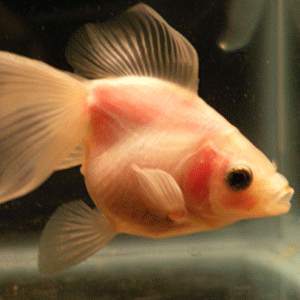
Matte scales have a flat coloration. Goldfish with matte scales usually display a pale pink color as their scales are not reflective, but rather transparent. Matte scales are not very common nor popular, mostly due to the fact that they produce limited color options.
Nacreous scales are a cross between metallic and matte. These scales are semi-transparent, and while they lack the complete shine of metallic scales, some scales may still appear slightly reflective. Goldfish with this type of scale usually display a combination of colors in a mottled, calico-like pattern.
While metallic, matte, and nacreous scales are the most common varieties available, About Goldfish offers more information about subcategories of goldfish scales that can be achieved through cross-breeding.
Coloration in Goldfish
For goldfish, scale type and color are determined by a crystalline pigment called guanine, which causes the tissue to appear bluish-gray when deposited into the skin. Guanine is highly reflective and contains pigment cells called chromatophores that react to environmental factors and create color. The amount of guanine present in the skin of the goldfish and the depth at which it is deposited determines the goldfish’s scale type.
Metallic scales are a result of a large amount of guanine. When a large amount of guanine is present, there is also an abundance of xanthophores and erythrophores, which are two types of chromatophores. Xanthophores create red coloration and erythrophores create orange and yellow coloration. The coloring seen in metallic goldfish is typically very stable, which means it will change very little through its lifetime.
Matte scales are the result of the absence of guanine. The lack of pigment cells is what leads to the transparent scales seen in these goldfish. Any visible color is typically due to the blood in the skin and muscle tissues, which shows through the transparent scales and creates a light pink color.
Nacreous scales are the result of the presence of some guanine, which creates a hybrid of three different types of scales. Some scales may appear metallic and matte, while others are transparent but have a layer of guanine on the upper side of the scales, which gives them a pearlescent shine. Nacreous scales are responsible for the calico color pattern, which can display areas of blue, red, yellow, orange, blue, purple, brown, black, white, and/or grey.
This chart provides more information about which pigment cells lead to the different color combinations seen in goldfish. It’s important to note that while the color of goldfish may change slightly through the course of its life, sudden or drastic color changes can be cause for concern. In some instances, a change in color can indicate poor water quality or illness. You can find more information about goldfish illness in our Comprehensive Guide To Goldfish Diseases.
Pond Goldfish Varieties
Comet Goldfish
Scale Type: Metallic
Average Size: 6-10”, with a tail that can reach 12” in length
Color: Primarily red or red-orange, sometimes with areas of white
Comet Goldfish have a long, slim body, a curved dorsal fin, and a flat, vertical tail. The Comet Goldfish is the only goldfish variety that originated in the United States. These goldfish are comparable to the common goldfish, but the comet has longer fins, a slimmer body, and typically displays a more reddish color–rather than the classic orange seen in the common goldfish.
In a healthy environment, Comet Goldfish will typically live 10 to 15 years in an outdoor pond. Comets are known to be exceptionally hardy fish, which makes them a great addition to any pond, including those in cooler climates, and a perfect pick for new hobbyists.
Comet Variations

The two common variations of comets are the Red Comet and the Sarasa Comet. Red Comets display solid red coloring. Sarasa Comets have a bright, red body with areas
of white patches. Red Comets and Sarasa Comets can have either short, rounded fins or long, flowing fins. Comets with this type of flowing fin are referred to as Veiltail Comets. Creamsicle Comets are a third and rarer variety. As the name suggests, these goldfish display a light orange color, which is the result of a combination of stock goldfish and yellow goldfish. You won’t find creamsicle comets anywhere else—this variety is exclusive to Next Day Koi.
Blackout Comet
Scale type: hybrid
Average size: 6-10”
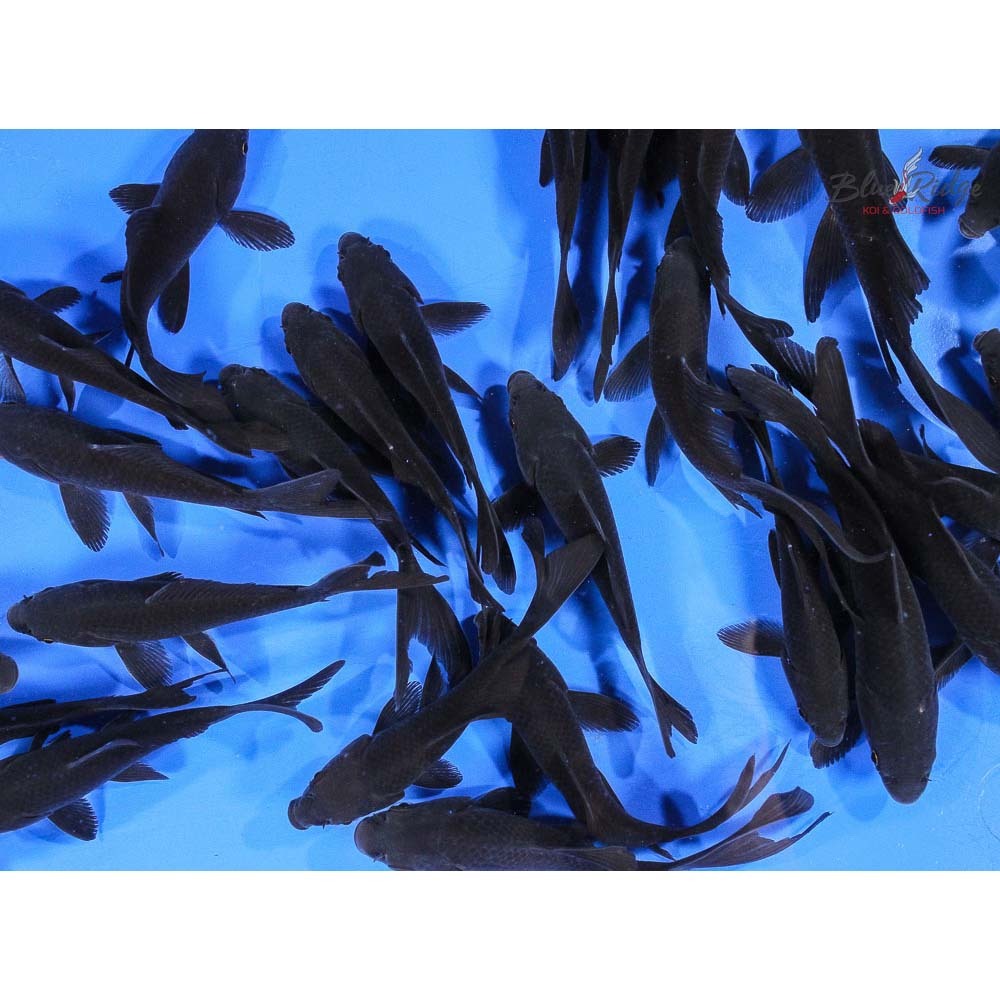
Color: Black
Blackout Comets are a relatively new type of hybrid fish that display a deep, solid black color. The exact origin of Blackout Comets is unknown, but they are likely the result of crossbreeding koi and goldfish. Typically, a comet that is initially black will eventually change red or orange. Due to selective breeding, this isn’t the case for Blackout Comets, and the black on this variety is stable throughout its lifespan. The body shape resembles that of comet goldfish, with a long, slim body and flat, vertical tail. This variety is not known to reproduce and is likely sterile.
Fantail Goldfish
Scale Type: Metallic or nacreous
Average size: 6-8”
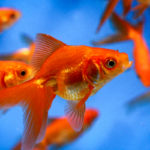
Color: Come in a wide range of colors. Orange, yellow, and red tend to be the most common.
Fantail Goldfish are similar to fancy goldfish, but common fantails are hardier than fancy goldfish and come in fewer varieties. Fantail Goldfish have several features that differentiate them from other types of pond goldfish, the most notable being the body shape. Rather than the long, slim body seen in comets, fantails have a short, egg-shaped body. Fantails have an arched dorsal fin, double anal fins, and a wide, double fantail. This variety of goldfish can live up to ten years.
Fantail Variations
Fantail Goldfish can be found in three variations: Red Fantail, Sarasa Fantail, and Calico Fantail. Similar to Comets, Red Fantails have a solid red coloration, and Sarasa Fantails are red with areas of white. Calico Fantails display a blue or white base with mottled patterns of red, orange, blue, and/or black.
Shubunkin
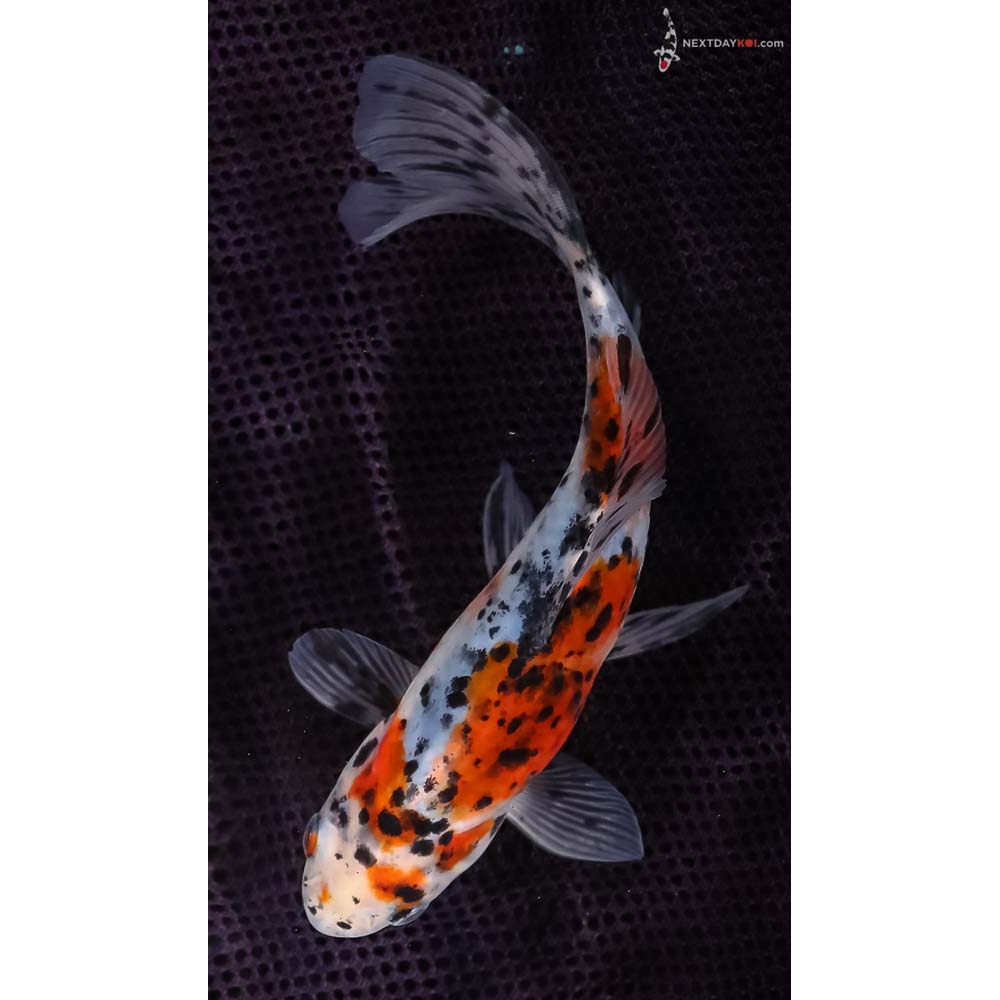
Scale type: Nacreous
Average size: 8-14”
Colors: Combination of a variety of colors
Shubunkin Goldfish have the same long, slim body and curved dorsal fin as Comets do, but Shubunkin have longer tail fins. What makes this goldfish variety popular is its unique coloration. Shubunkin typically have a calico pattern with a blue-ish base and areas of red, yellow, orange, blue, purple, brown, black, white, and/or grey. The pattern can appear as patches or speckles. The lifespan of Shubunkin can reach up to 15 years.
Wakin
Scale type: Metallic or nacreous
Average size: 10-12”
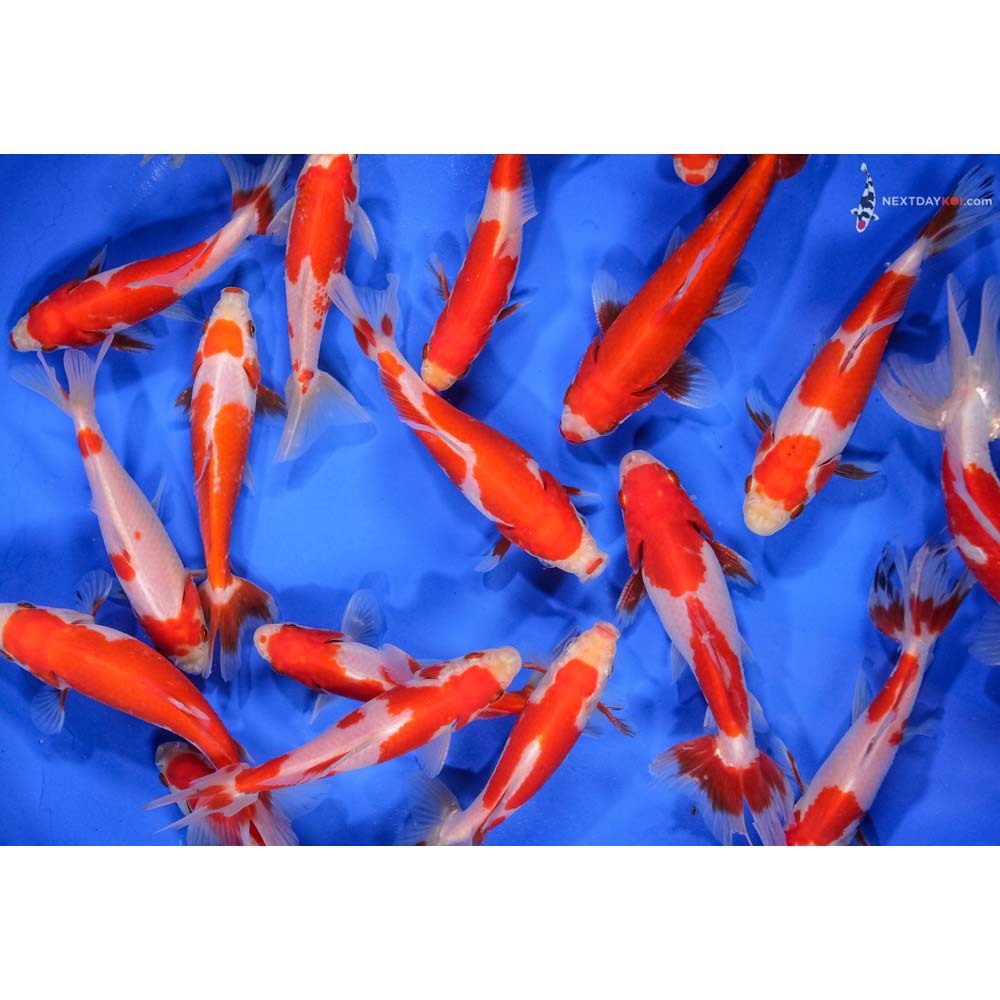
Colors: Traditionally red and/or white. Though less common, other color combinations are also possible.
Wakin Goldfish resemble a combination of a Comet Goldfish and a Fantail Goldfish. They have a long, slender body shape like Comets and the double tail seen in Fantails. Wakin tails are typically not as long as that of Fantails, though the Wantonai variety of Wakin have longer tails that are akin to Fantail Goldfish. Wakin also have a long, upright dorsal fin that will sometimes cover the entire back. The average life expectancy for this variety of goldfish is 12 years.
We offer a wide variety of beautiful goldfish for sale. If you’re interested in adding new goldfish to your pond, visit our website to browse our full selection of individual goldfish and pond pack goldfish.

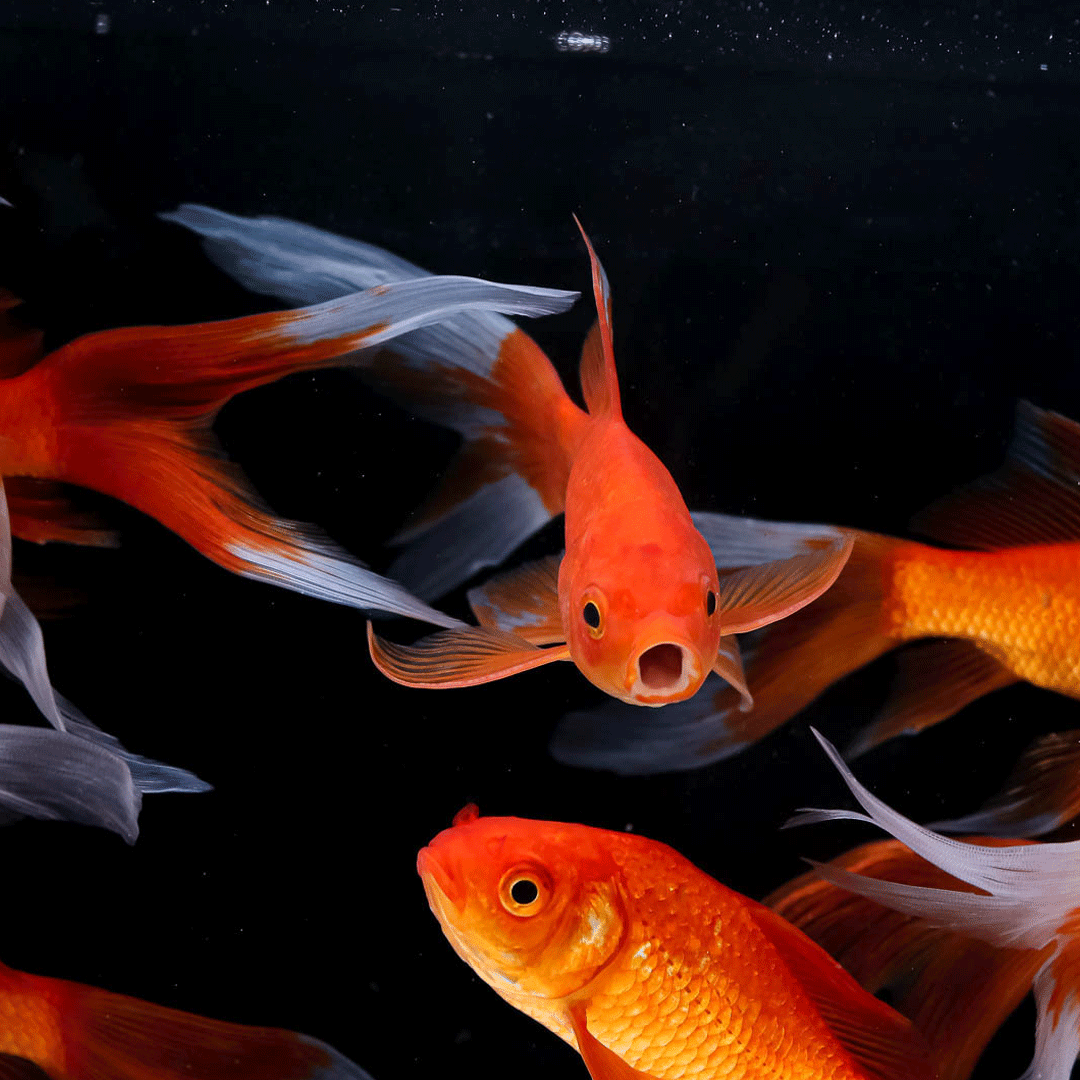
Looking for pond goldfish, I want color like black something different from orange. I have a 3000 gallon pond. I have 10 koi in there.
Just purchased a 60 gallon tank.
Looking forward to getting 3 butterflies koi.
[…] Goldfish are natural friends of koi as they both are part of the carp family. Koi and goldfish share the same water condition needs and adapt similarly to weather. If you decide to combine the two, you might need to increase the power of your filtration system as goldfish and koi are true relatives when it comes to producing waste–a lot of it. […]